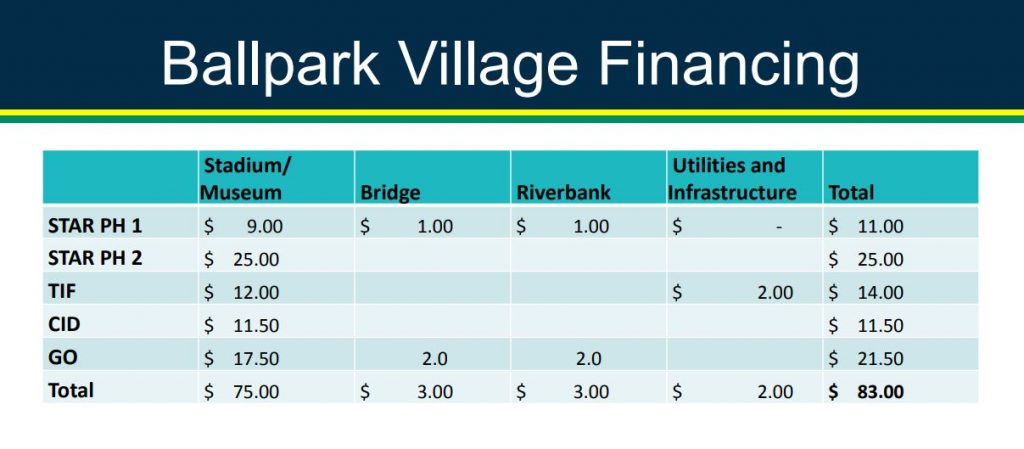The Wichita City Council gave the go-ahead to private development of a new $75 million stadium to house the relocating New Orleans Baby Cakes, a triple-A minor league baseball team. Wichita has been working toward securing a new minor league baseball team – ideally with a Major League affiliation – for years, but in earnest since about 2017.
The project is being financed through four channels of funding consisting of STAR bonds, Tax Incremental Financing (TIF), Community Improvement District (CID) project funds, and General Obligation Bonds. The total price tag including, stadium, bridge and riverbank development on top of utilities and infrastructure is $83 million. According to Wichita Assistant City Manager Scot Rigby the four channels, or buckets as Rigby calls them, are meant to cover the financing of the ballpark.
“Our projections are we’d have enough revenue generation to cover the debt service on the stadium,” says Rigby.

Kansas law requires that comprehensive financial feasibility studies be conducted in advance of a project for STAR Bonds to be used for financing.
A feasibility study must demonstrate that income derived from a project will exceed the cost of a project. The City of Wichita put out a feasibility study in June 2017 which shows the stadium project is expected to cover the cost. However, the cost to build a stadium in the feasibility study is $12 million. Rigby notes that the $12 million in the preliminary study looked at the price to build the stadium as it related to a specific channel, in this case, TIF’s.
Another document on STAR Bonds from the city pegs the cost of a stadium at $50 million noting that, “total district sales will exceed $50 million beginning in the year 2030. This is the cost to build the stadium as it relates to STAR Bonds.
At a March 19th, 2019 meeting the Wichita City Council voted to go ahead with the private development agreement part of the stadium deal. This included approving Wichita Riverfront LP, a group made up of undisclosed private developers and owners of the relocating team to purchase four acres of land valued between $750,000 and $800,000 for $1 an acre. Yet, Jeffrey Dorfman, an economist at the University of Georgia, says the only way publicly subsidized stadiums work is if surrounding development does not need to be subsidized.
“The only time it is ever going to be successful and worth it to subsidize a sports stadium is if you can spur a whole lot of other business development that you do not have to subsidize around it,” says Dorfman. “The goal is to try and incentivize one big thing at the start and then make everyone else pay the full price.”
The projected return on investment for the city from sales tax within the TIF and STAR bond districts, along with naming rights and management fees could garner $38.5 million by 2042. The Baby Cakes team commitment is for 20 years with two additional optional five-year terms. There is a risk that the team could leave for greener outfields and newer stadiums before the $38 million is collected. Dorfman says the depreciation of stadiums is a problem.
“In 20 years it will be worth nothing. They will have to do either major retrofit or tear it down and build a new one,” says Dorfman.
Wichita is not alone though in the money getting handed out through incentives and bonds to attract sports teams. However, the amount of tax money that gets missed out on when cities create tax-free bonds to finance construction is an issue. Municipal bonds used for stadium project development is exempt from federal taxes. That ends up equating to a large amount of money that is a de facto federal subsidy since the city is picking a business to receive a new place of business at not only taxpayer expense if it never becomes revenue neutral, but also a loss in federal tax revenue.
According to the Brooking Institute since 2000, more than 35 professional sports stadiums have been financed with these tax-exempt bonds. A reason for why cities push for sports stadiums is a belief that new stadiums will benefit the economy. Dorfman believes politicians reap the greatest benefits.
“I think politicians think it makes them look good. Politicians like being at ribbon cuttings and acting like they are bringing in lots of jobs and new projects and development and moving their cities forward,” says Dorfman.
There is little evidence that the stadiums do provide economic benefits. Part of the reason for this is that visitor numbers to a venue are conflated to equal tax revenue, but this creates competition for other activities in the area. Attendance numbers in one part of town undercut attendance in other sectors of the community. New stadiums do not create disposable income.
“There is growing opposition to municipal governments that use their powers to create municipal bonds that are a tax-free interest for things that aren’t really public projects,” says Dorfman.
The federal government is not naïve to the tax-free benefits privately held teams are getting from cities. Congress tried to address the issue with the Tax Reform Act of 1986. Brookings Institute recommended the elimination of the “private payment test” for stadiums. This would mean that any stadium used mostly for private business, which is the vast majority, would no longer be eligible for Federal tax-exempt financing.
Yet, Rigby says that the financing structure the city put into place to pay for the stadium is based on a demand structure. This means that the tax burden is placed on people going to the ballpark and shopping or eating around the stadium through STAR bonds and TIF districts.
“You understand by doing that you may pay a little additional sales tax to do that,” says Rigby.
Rigby says should revenues from STAR, TIF and CID’s meet projections the need to use general obligation funds to make up the difference would be minimized.
“If the three: STAR, CID and TIF perform even better than what we are projecting that may help reduce the amount of GO we are projected to use for the project,” says Rigby.
The tax burden for Wichitans, who do not visit the ballpark, rests on the performance of three independent and complicated programs.


